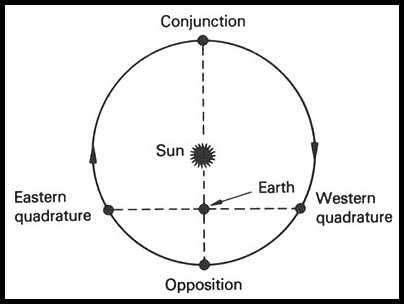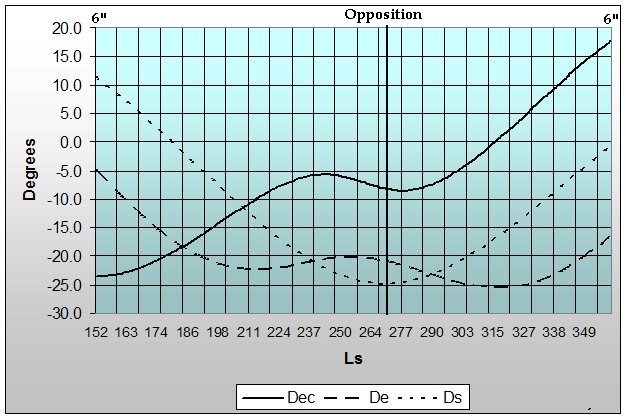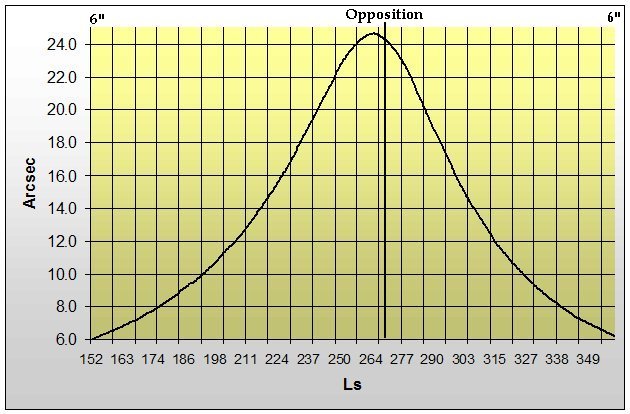
INTRODUCTION
Mars appears more Earth-like to us than most of the other planets because we can observe its surface, atmospheric clouds and hazes, and its brilliant white polar caps. The latter are composed of frozen CO2 and underlying water ice, and wax and wane during the Martian year. These aspects, along with the changing seasons and the possibility of life, have made Mars one of the most studied planets in our solar system.
The Red Planet Mars offers both casual and serious observers many challenges and delights, as well as providing astronomers a laboratory to study another planet’s atmosphere and surface. Some Martian features even appear to shift position around the surface over extended periods of time. There are several cooperating international Mars observing programs under way to assist both professional and amateur astronomers. These include the International Mars Patrol (I.M.P.) coordinated by the Mars Section of the Association of Lunar and Planetary Observers (A.L.P.O) and the Terrestrial Planets Section of the British Astronomical Association (B.A.A.). Information for observing Mars during a typical apparition is presented in a separate report titled, “General Information for Apparitions of Mars.” Also, you can find gobs of information at this site.
With the advent of modern CCD camera technology the amateur can produce useful images of Mars when it is as small as 3.5 arcsec. Early in an apparition, Mars rises in the east or morning sky and sets with the rotation of the Earth in the western or evening sky. During the past few apparitions (2027-2033), observers began to take CCD images when Mars was only 32 degrees away from the Sun. Since Mars was only a visual magnitude of ~1.8 then the planet would have been difficult to locate bright twilight hours.
In the pre-apparition reports the observer will find the motion of Mars in our sky, the characteristics for that particular apparition, information pertaining to the polar cap(s) and any special events that may be seen during that particular apparition. As usual a calendar of events will be included with each report that contains cardinal dates for seasonal activity and orbital information of Mars.
MOTION OF MARS IN OUR SKY
As a general rule, an "apparition" begins when a planet emerges from the glare of the Sun shortly after conjunction. Mars will be in conjunction with the Sun on August 19, 2034 (13.9° Ls); however, it will not be safe to observe Mars until after September 24, 2034 when it is at least 12 degrees away from the glare of the Sun.
The apparent declination of Mars begins at -23.6° by the first week in March 2035 in the constellation Sagittarius and will ascend north into the constellation Capricornus by April 11, 2035 and then into Aquarius on May 24th. Mars will be south of the celestial equator until December 05, 2035 when it will then cross north of the celestial equator. This is not good news for those observing in the Northern Hemispheres because Mars will be seen fairly low in their sky during the much of the apparition. Good news for southern hemisphere observers however.
By March 05, 2035, a '1.0' visual magnitude Mars will be seen rising early in the morning sky in the constellation Sagittarius and it will be at western quadrature with the phase defect or terminator of 37.3°. NOTE: The Solar Elongation for Mars is the angle between the lines of sight from Earth to the Sun and from Earth to Mars. When these lines of sight form a right triangle then Mars is at quadrature (eastern or western). For detailed definitions and graphics for the motion of Mars in our sky see these excellent web sites: Planetary Aspects and Elongations and Configurations.

Figure 1. A heliographic chart of the orbits of Mars and the Earth showing the relative positions of both planets. Quadrature is when Mars is directly east or west of Earth as shown.
The 2035-2036 apparition of Mars begins retrogression, or retrograde motion against the background stars eleven months after conjunction on August 15, 2035 (247.2° Ls) and continues through October 15, 2035 (285.5° Ls). Each night for this brief period of time; before, during and after opposition the Red Planet will appear to move backwards toward the western sky in Pisces and Aquarius. Since the Martian year is about 687 Earth days long -- nearly twice as long as ours, the Martian seasons are similarly extended. While the Earth's seasons are nearly equal in duration, the Martian seasons can vary by as much as 52 days from each other due to that planet's greater orbital eccentricity (see Figure 2).

Figure 2. A heliographic chart of the orbits of Mars and the Earth showing the relative seasons of both planets in the planetocentric longitude system Ls. Graphic Ephemeris for the 2035 Aphelic Apparition of Mars. Original graph prepared by C.F. Capen and modified by J.D. Beish.
2035 APPARITION
CHARACTERISTICS
Another general rule for predicting oppositions of Mars is from the following: the planet has an approximate 15.8-year periodic opposition cycle, which consists of three or four Aphelic oppositions and three consecutive Perihelic oppositions. Perihelic oppositions are also called "favorable" because the Earth and Mars come closest to each other on those occasions. We sometimes refer to this as the seven Martian synodic periods. This cycle is repeated every 79 years (± 4 to 5 days) and, if one were to live long enough, one would see this cycle nearly replicated in approximately 284 years. The 2035 Mars apparition is considered Perihelic because the orbital longitude at opposition will be 17.3° from the longitude of perihelion (250° Ls).
NOTE: Ls is the planetocentric longitude of the Sun along the ecliptic of Mars’ sky. 0° Ls is defined as that point where the Sun crosses the Martian celestial equator from south to north, that is the planet’s northern hemisphere vernal equinox. The other Ls values that define the beginnings of Martian northern hemisphere seasons are: summer, 90° Ls; autumn, 180° Ls; and winter, 270° Ls. For Mars’ southern hemisphere these values represent the opposite seasons. Distance (A.U.) - Distance from Earth to Mars in astronomical units, where one (1) A.U. equals 92,955,807.267 miles or 149,597,870.691 km.
Closest approach occurs at 1421 UT on September 11, 2035 (264.7° Ls) with an apparent planetary disk diameter of 24.6'' at a distance of 0.3804083 astronomical units (AU) or 36,361,156 mi (56,908,264-km). During closest approach in 2035 the apparent diameter of Mars will be 2.5 arcsec larger than it was at the same period in 2033; however, it will be 20.5 degrees higher in the sky - good for observing the Red Planet for observers in both hemispheres of Earth. It should also be noted that closest approach between Earth and Mars is not necessarily coincident with the time of opposition but varies by as much as two weeks.
Opposition nearly 13 months after conjunction when Mars is on the opposite side of the Earth from the Sun. At that time, the two planets will lie nearly in a straight line with respect to the Sun, or five weeks after retrogression begins. Opposition will occur at 1933 UT on September 15, 2035 (267.3° Ls) with an apparent planetary disk diameter of 24.5 arcsec. Mars will remain visible for around 11 months after opposition and then become lost in the glare of the Sun around August 18, 2036 as it approaches the next conjunction (September 23, 2036). The cycle is complete in 780 Earth days.
Figure 3. A simulated view of the appearance of Mars during opposition at 1933 UT on September 15, 2035 (267.3° Ls, CM 178.6°)
The observable disk diameter of Mars will be greater than 6 arcsec from March 05, 2035 [-23.6° δ ] (151.3° Ls) and will not fall below this value until February 26, 2036 (0.4° Ls), lasting nearly 12 months or 209 degrees Ls. Imaging by CCD devices may begin with a disk diameter of 4.5 arcsec or more, commencing on or about January 01, 2035.
The Sub-Earth (De) and Sub-Solar
(Ds) points are graphically represented in Figures 4
and 5. The 2035-2036
Ephemeris of Mars is tabulated on Internet in this web
site. A glossary of Terms appears at the end of this
table.

Figure 4. As it approaches Earth, it will swell from a small apparent disk of 6" in March 05, 2035 to a maximum diameter of 24.6" at closest approach on September 11, 2035 and then shrink as it moves away. Images shown at 0h UT.

Figure 5. Graphic Ephemeris of Mars during the 2035-2036 apparition from March 05, 2035 through February 26, 2036. Opposition September 15, 2035 (267.3° Ls) and 6 arcsec apparent diameter range are indicated. Plot illustrates the Declination (solid line), the latitude of the Sub-Earth point (De) or the apparent tilt (dashed line) in areocentric degrees, and the latitude of the Sub-Solar point (dotted line) in areocentric degrees. The areocentric longitude (Ls) of the Sun, shown along the bottom edge of the graph defines the Martian seasonal date. The value of Ls is 0° at the vernal equinox of the northern hemisphere, 70° when Mars is at aphelion, and 90° at the summer solstice of the northern hemisphere 251° when Mars is at perihelion, and 180° is northern autumn..

Figure 6. Graphic Ephemeris of Mars from March 05, 2035 through February 26, 2036. Opposition September 15, 2035 (267.3° Ls) and 6 arcsec apparent diameter range are indicated. Plot illustrates the apparent diameter of Mars in seconds of arc. The areocentric longitude (Ls) of the Sun, shown along the bottom edge of the graph defines the Martian seasonal date.
THE SOUTH POLAR REGION
Astronomers will have a view of the Martian South Polar Region (SPR) will be tilted toward the Earth and will remain so throughout the apparition. For more detailed information on the south polar cap click to this web site.
DUST STORMS
Observers should be aware that during the next apparition of Mars in 2035 a major dust storm may occur to block our view of the clouds and surface of the Red Planet. While it is nearly impossible to predict these events our studies show that the Martian dusty season should begin on or about March 30, 2035 (165° Ls) through February 25,2036 (359° Ls) with the highest probability around the last week in August (255° Ls) and again peaking December 03 (315° Ls). Massive, planet-encircling storms usually occur in the southern hemisphere summer and usually in sensitive areas for the development of dust storms are in northwest Hellas.
Do not be surprised if another early dust storm occurs on or about May 04, 2035 (184 Ls). Observers should be alert for dust clouds in the northeast Hellas Basin, the Serpentis-Noachis region, and the Solis Lacus region For more detailed information on Martian dust storms on this web site.
CALENDAR OF EVENTS -- MARS, 2035 - 2036
|
DATE |
PHYSICAL |
REMARKS |
|
2034 Aug 19 |
Ls 13.9° |
Conjunction. Mars is behind the Sun ~2.675 AU. |
|
2035 Mar 04 |
Ls
151.8° |
Apparition
begins for observers using 4-inch to 8-inch
apertures telescopes and up. Begin low-resolution CCD imaging. Views of
surface details not well defined. Mid-summer. Northern clouds
frequent. Syrtis Major broad. Are both polar hoods visible? |
|
2035 Apr 19 |
Ls
175.9° |
Late
southern winter, SPH present and edge of NPH visible. |
|
2035 Apr 26 |
Ls
180° |
Equinox
- Northern Autumn/Southern Spring. South Polar Cap (SPC) maximum width. Is the
North Polar Hood present? Does SPH or frost cover |
|
2035 May 04 |
Ls 184.3° |
Mars at Quadrature. South Polar Cap (SPC) maximum width. Is the North Polar
Hood present. Does SPH or frost cover |
|
2035 May 19 |
Ls
193.0° |
SPC
should be free of its hood, large and bright. Possible W-clouds in Tharsis-Amazonis. Syrtis Major shrinks or fading on eastern
border. NPH bright. White areas brighter? White areas brighter? Within Hellas
the features Zea Locus and |
|
2035 Jun 10 |
Ls
206.0° |
SPC
develops dark Magna Depressio at (270°W, 80°S).
Syrtis Major narrows rapidly. W-clouds? At 215°Ls Rima Australis
(a dark rift) appears connected with Magna Depressio
from 20° to 240° longitude; and SPC develops bright projection at 10° - 20°
longitude in Argenteus Mons (10°-20°W). Dust cloud
in Serpentis-Hellaspontus or Noachis-Hellas?
Syrtis Major very narrow? |
|
2035 Aug 15 |
Ls
247.2° |
Retrogression
Begins.
SPC in rapid retreat. Novus Mons smaller. Dust clouds expected over Serpentis-Hellaspontus (Ls 250° - 270). Syrtis Major
beginning to narrow. Frost in bright deserts? Orographic clouds (W-clouds)
possible. Elysium and Arisa Mons bright?
Note: Several "planet-encircling dust storms have been reported during
this season. High probability for dust clouds at 255° Ls. |
|
2035 Aug 19 |
Ls 250° |
Mars
at Perihelion. SPC
in rapid retreat. Novus Mons smaller. Dust clouds expected over Serpentis-Hellaspontus (Ls 250° - 270). Syrtis Major
beginning to narrow. Frost in bright deserts? Orographic clouds (W-clouds)
possible. Elysium and Arisa Mons bright?
Note: Several "planet-encircling dust storms have been reported during
this season. High probability for dust clouds at 255° Ls. |
|
2035 Sep 11 |
Ls
264.3° |
Mars
at Closest Approach. Novus Mons reduced to a few bright
patches and soon disappears. Windy season on Mars begins, dust clouds
present? Watch for initial dust clouds in south. White patches in bright
areas? |
|
2035 Sep 15 |
Ls 266.8° |
Mars at
Opposition.
W-clouds present? NPH extends 50° N? Decreased number of White clouds.
"Syrtis Blue Cloud"? White areas in deserts? Dust clouds in south
until 270° Ls? Watch for planetary system clouds bands. Orographic cloud over
Arsia Mons? Syrtis Major is narrow. |
|
2035 Sep 20 |
Ls
270° |
Solstice
- Northern Winter/Southern Summer. W-clouds present? NPH extends 50° N? Decreased number of
White clouds. "Syrtis Blue Cloud"? White areas in deserts? Dust
clouds in south until 270° Ls? Watch for planetary system clouds bands.
Orographic cloud over Arsia Mons? Syrtis Major is
narrow. |
|
2035 Oct
15 |
Ls
285.5° |
Retrogression
Ends. NPH extends 50° N? White clouds
rare. Dust storm? Frost patches? Dust storms visible at 285° Ls (Martin &
Zurek). Look for orographic clouds
over the Tharsis volcanoes. Orographic cloud over Arsia
Mons? W-Cloud? SPC small |
|
2035 Dec 03 |
Ls 314.8° |
|
|
2035 Dec 22 |
Ls 325.6° |
Novus
Mons reduced to a few bright patches and soon disappears. Windy season on
Mars begins, dust clouds present? Watch for initial dust clouds in south.
White patches in bright areas? |
|
2036 Jan 16 |
Ls 339.2° |
NPC
large hood present. W-Cloud? Orographic cloud over Arsia
Mons? Topographic cloud over |
|
2036 Feb 25 |
Ls 0° |
Equinox
- Northern Spring/Southern Autumn. North Polar Hood (NPH) breaking up, North Polar Cap
(NPC) should be exposed. ("Areo-" is a
prefix often employed when referring to Mars or "Ares.") |
|
2036 Sep 23 |
Ls 95.4° |
Conjunction. Mars is behind the Sun ~2.664AU. |